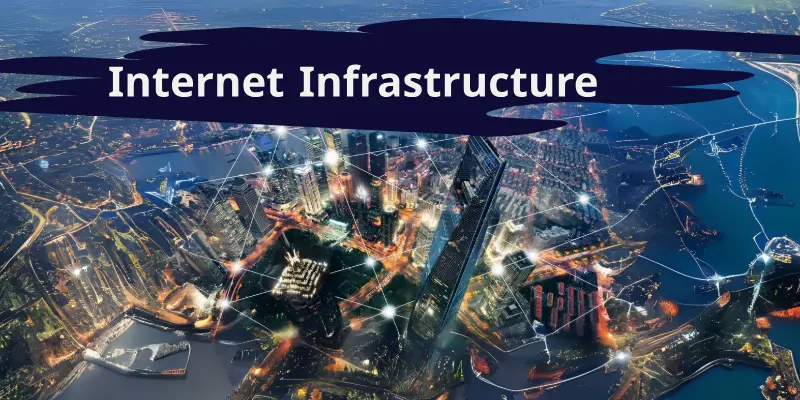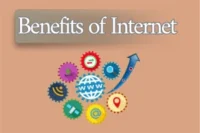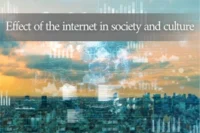The Backbone of the Internet: Understanding Internet Infrastructure
Published: 26 May 2025
Every Google search, Netflix stream, and Zoom call relies on a vast network of cables, servers, and protocols. This internet infrastructure, the physical and digital framework of the web, ensures global connectivity. From undersea cables to AI-driven security, this guide explores how data travels worldwide and what the future holds.
Physical Components of Internet Infrastructure
The internet’s physical infrastructure consists of various components that enable data transmission across the globe.

Submarine Cables: The Underwater Superhighways
- Role: Over 99% of international internet traffic passes through more than 436 submarine cables.
- Key Routes: Examples include MAREA (connecting the U.S. and Europe) and Asia-Africa-Europe-1.
- Interesting Fact: A single cable can transfer over 200 terabits per second, enough for 10 million simultaneous Zoom calls!
Data Centers: The Internet’s Storage Hubs
Data centers store and process the massive amounts of information that power the internet.
- Types:
- Hyperscale Data Centers: These are operated by tech giants like Google, AWS, and Microsoft Azure.
- Edge Data Centers: Smaller, localized centers that enhance streaming speeds (e.g., Netflix’s Open Connect).
- Sustainability Initiatives: Innovations include Microsoft’s underwater data centers and Google’s geothermal cooling efforts.

Satellites & Wireless Networks
Satellites and wireless technologies provide internet access where cables cannot reach.
- Starlink: Low Earth Orbit (LEO) satellites providing broadband internet to remote areas.
- 5G Towers: Enhancing speed and reducing latency for smart cities and autonomous vehicles.
Routers, Switches, and Internet Exchange Points (IXPs)
- IXPs (Internet Exchange Points): Key hubs where networks interconnect, such as DE-CIX in Frankfurt.
Logical Components: Protocols and Standards
The internet functions through a set of rules and protocols that ensure data reaches its intended destination.
TCP/IP: The Internet’s Communication System
- Divides data into packets, routes them, and reassembles them at the destination.
DNS: The Internet’s Directory
- Translates domain names (e.g., “google.com”) into IP addresses (e.g., 142.250.190.78).
BGP Routing: The Internet’s Traffic Manager
- Directs data between networks. However, vulnerabilities like BGP hijacking can disrupt services (e.g., the 2018 Amazon Route 53 outage).
HTTP/3 & QUIC
- Enhanced protocols offering faster, encrypted browsing experiences.
Standards Organizations
- IETF (Internet Engineering Task Force): Develops protocols like TLS.
- ICANN (Internet Corporation for Assigned Names and Numbers): Oversees domain names and IP address management.
Key Players in Internet Infrastructure
The internet functions through a set of rules and protocols that ensure data reaches its intended destination.
| Category | Role | Examples |
| Tier 1 ISPs | Global network backbone providers | AT&T, Deutsche Telekom |
| Cloud Providers | Host vast amounts of data | AWS, Google Cloud |
| CDNs (Content Delivery Networks) | Improve content delivery speeds | Cloudflare, Akamai |
Security and Vulnerabilities
The internet faces constant security threats, requiring robust protection measures.
Major Threats
- DDoS Attacks: Overloading networks (e.g., 2020 AWS outage).
- Submarine Cable Vulnerabilities: 95% of cables have minimal physical protection.
Security Measures
- TLS 1.3: Encrypts data for secure communication.
- Zero Trust Security: A “never trust, always verify” approach to access control.

Global Challenges
Despite advancements, the internet infrastructure faces various global challenges.
IPv4 Exhaustion
- Only 3.7 million IPv4 addresses remain, while IPv6 offers 340 undecillion unique addresses.
The Digital Divide
- 37% of the world still lacks internet access, particularly in Africa and rural Asia.
Regulatory Issues
- Data Privacy Laws: GDPR in the EU vs. restrictive policies like China’s Great Firewall.
Future Trends
Emerging technologies are shaping the next generation of internet infrastructure.
Edge Computing
- Processes data closer to users, improving response times for IoT applications.
Quantum Networking
- Offers ultra-secure communication but poses challenges to current encryption methods.
Sustainable Infrastructure
- Google aims for 100% renewable energy in data centers by 2030.
Case Studies
Real-world scenarios highlight the impact of internet infrastructure.
How a TikTok Video Reaches Your Phone
- The creator uploads a video to TikTok’s cloud servers (likely hosted on AWS).
- CDNs cache the video worldwide for faster access.
- Your ISP routes the video via submarine cables or 5G networks.
2022 Tonga Volcanic Eruption
- A volcanic eruption severed undersea cables, cutting off Tonga’s internet for weeks.
Conclusion
Internet infrastructure is a blend of engineering marvels and digital protocols that sustain our online world. As AI, 6G, and quantum technology advance, internet systems must evolve to keep pace. Whether you’re a business optimizing network performance or a traveler relying on Starlink, understanding this framework helps make informed digital choices.
Share this guide to spread awareness, or leave a comment with your questions about internet infrastructure!
FAQs
The following are common questions about internet infrastructure and its challenges.
BGP directs traffic between ISPs. A hijacking attack can reroute data to cybercriminals.
Costs and compatibility issues hinder widespread IPv6 adoption despite IPv4 shortages.
No cables handle 99% of global data traffic. Satellites like Starlink serve as supplementary solutions.
Specialized ships locate and splice damaged sections. Repairs can cost up to $2 million.
It processes data closer to users (e.g., smart traffic lights) to minimize latency.
Hyperscale centers consume about 1% of global electricity. However, companies like Google are targeting carbon neutrality.
Tier 1 ISPs (e.g., Verizon) own global networks, while Tier 3 ISPs lease infrastructure from others.
Thousands of LEO satellites beam internet signals to ground-based receivers.
Content Delivery Networks (e.g., Cloudflare) store cached data closer to users to enhance load times.
Yes, quantum computers could crack current encryption, necessitating a shift to quantum-safe algorithms.

- Be Respectful
- Stay Relevant
- Stay Positive
- True Feedback
- Encourage Discussion
- Avoid Spamming
- No Fake News
- Don't Copy-Paste
- No Personal Attacks

- Be Respectful
- Stay Relevant
- Stay Positive
- True Feedback
- Encourage Discussion
- Avoid Spamming
- No Fake News
- Don't Copy-Paste
- No Personal Attacks





